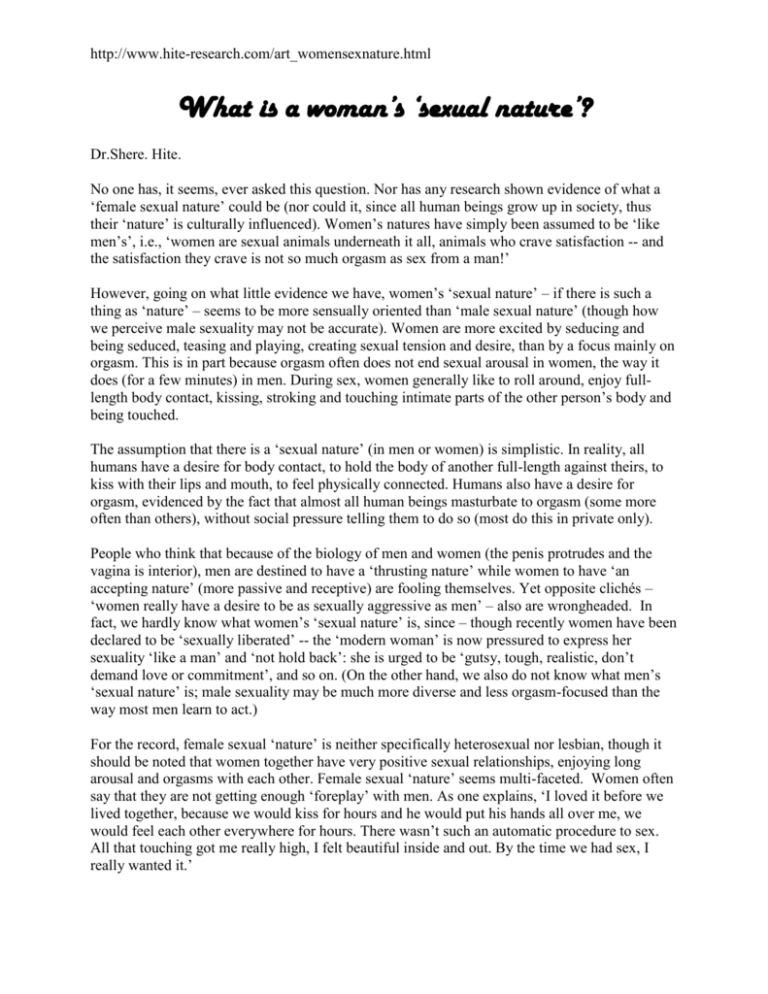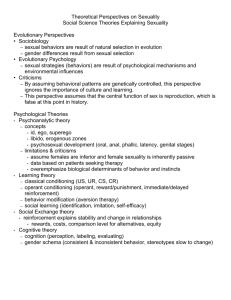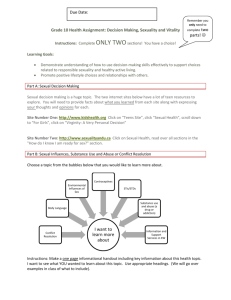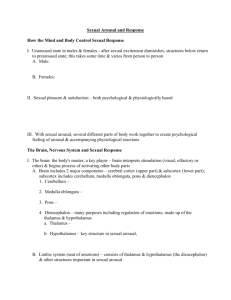
http://www.hite-research.com/art_womensexnature.html
What is a woman’s ‘sexual nature’?
Dr.Shere. Hite.
No one has, it seems, ever asked this question. Nor has any research shown evidence of what a
‘female sexual nature’ could be (nor could it, since all human beings grow up in society, thus
their ‘nature’ is culturally influenced). Women’s natures have simply been assumed to be ‘like
men’s’, i.e., ‘women are sexual animals underneath it all, animals who crave satisfaction -- and
the satisfaction they crave is not so much orgasm as sex from a man!’
However, going on what little evidence we have, women’s ‘sexual nature’ – if there is such a
thing as ‘nature’ – seems to be more sensually oriented than ‘male sexual nature’ (though how
we perceive male sexuality may not be accurate). Women are more excited by seducing and
being seduced, teasing and playing, creating sexual tension and desire, than by a focus mainly on
orgasm. This is in part because orgasm often does not end sexual arousal in women, the way it
does (for a few minutes) in men. During sex, women generally like to roll around, enjoy fulllength body contact, kissing, stroking and touching intimate parts of the other person’s body and
being touched.
The assumption that there is a ‘sexual nature’ (in men or women) is simplistic. In reality, all
humans have a desire for body contact, to hold the body of another full-length against theirs, to
kiss with their lips and mouth, to feel physically connected. Humans also have a desire for
orgasm, evidenced by the fact that almost all human beings masturbate to orgasm (some more
often than others), without social pressure telling them to do so (most do this in private only).
People who think that because of the biology of men and women (the penis protrudes and the
vagina is interior), men are destined to have a ‘thrusting nature’ while women to have ‘an
accepting nature’ (more passive and receptive) are fooling themselves. Yet opposite clichés –
‘women really have a desire to be as sexually aggressive as men’ – also are wrongheaded. In
fact, we hardly know what women’s ‘sexual nature’ is, since – though recently women have been
declared to be ‘sexually liberated’ -- the ‘modern woman’ is now pressured to express her
sexuality ‘like a man’ and ‘not hold back’: she is urged to be ‘gutsy, tough, realistic, don’t
demand love or commitment’, and so on. (On the other hand, we also do not know what men’s
‘sexual nature’ is; male sexuality may be much more diverse and less orgasm-focused than the
way most men learn to act.)
For the record, female sexual ‘nature’ is neither specifically heterosexual nor lesbian, though it
should be noted that women together have very positive sexual relationships, enjoying long
arousal and orgasms with each other. Female sexual ‘nature’ seems multi-faceted. Women often
say that they are not getting enough ‘foreplay’ with men. As one explains, ‘I loved it before we
lived together, because we would kiss for hours and he would put his hands all over me, we
would feel each other everywhere for hours. There wasn’t such an automatic procedure to sex.
All that touching got me really high, I felt beautiful inside and out. By the time we had sex, I
really wanted it.’
http://www.hite-research.com/art_womensexnature.html
‘Foreplay’ – a vast category containing all the sensual activities so important to women for
stimulation – doesn’t mean just a 1-2-3 approach (kiss, touch two minutes, then get on with the
act), but a long, lingering body-heating wrestling match that goes on for at least twenty minutes
and more, as another woman describes: ‘My favourite activities during sex with my boyfriend
are when he takes me in his arms, then after awhile, he lies with his whole body on top of mine –
in bed, or on a sofa – and I can feel his whole body against mine. I can feel him breathing, feel
his face and his strong shoulders, his legs and his hard cock against me – we embrace together
like that until I run out of breath, usually. I find it exciting to feel him covering all of me,
especially when he tells me at the same time that he’s crazy about me, whispering in my ear and
moaning. It’s heaven.’
Another part of sexual expression or ‘foreplay’ that women find exciting is ‘exhibitionism’ -dressing up, displaying the body. Though the word has negative connotations, it is an ancient
form of sensuality and social participation. People like to look at entertainers like Madonna,
fashion models, film stars and other performers display themselves. Exhibitionism is wrongly
believed to be a ‘psychological problem’ (even a sin), allied to ‘narcissism’, rather than a simple
pleasure.
Why is it that many of the most important sensual activities women like to pursue with someone
they find attractive have no names, in most languages? For example, the pleasure most seek
sexually in the full-length extension of their body pressing against the full-length body of another
person – has no name, generally being assumed to be part of the vague category ‘foreplay’. An
activity that has no name is undervalued and difficult to access. The most glaring example of this
nameless state is the stimulation most women find necessary for orgasm, i.e., can you imagine a
woman having to ask her partner, ‘Can you please stimulate my clitoris with your hand and don’t
stop until I have an orgasm?’ For stimulation by mouth, the question is somewhat easier though
the word is awkward, i.e., ‘cunnilingus’…
Women’s sensual ‘nature’ is somewhat different from men’s in that orgasm does not usually
signal ‘the end’ of the sexual arousal, as it can for men (for twenty minutes or so); to the
contrary, an orgasm in a woman can even lead to increased arousal. Also, coitus can function for
women as ‘foreplay ’ or ‘arousal’, increasing desire for clitoral stimulation to orgasm (by hand or
mouth), whereas the reverse is true for men (‘arousal’ comes before coitus, in most cases).
Eroticism is a vast, largely unexplored area which includes dressing up, playing, talking, making
up stories, posing, inviting someone else to be involved sensually with you. Passion and desire
are the objective, feeling one’s body come alive with another person.
Women want men to rethink their idea of sex, to include much more of this sensuality. Most now
think sex with a man should mean forging a new definition of sexuality between them, rethinking
the question of who orgasms when and how, the questions of which activities are included,
experimenting together. Sex, as the first Hite Report proposed, is a cultural rather than a
biological institution; our society’s idea of sex is formulated to suit reproductive needs, not
‘instinctive’ ones, and so can change. Will women now redefine sexuality? Women are making
many changes in how they see and practice intimate physical relations – how they express and
share their bodies. Though the choices are theirs, really theirs, it can still take some time to wake
up and see that one is free, in charge of one’ s life, that all decisions are possible; like sleeping
http://www.hite-research.com/art_womensexnature.html
beauty waking up, after 2,000 years of misinformation women need a little time to begin
thinking clearly. Unfortunately, women are currently encouraged to be ‘active’ in ‘male copycat
ways’, not in their own new ways – for example, performing actions that demonstrate intercourse
is making them more and more excited (may or may not be true), ‘initiating’ sexual activities
long defined to be ‘sexual ’ by men, or actively ‘acting up’ (counter to the ladies-don’t-like 'sex',
or Maria-is-pure-and-good stereotypes of women), wearing ‘sexy shocking outfits ’, etc.
In reality, being active in sex has an entirely different meaning for women, a meaning that is
only beginning to unfold. The semi pornographic images of women visible on so many
advertising posters and in television commercials (used by fundamentalists to point to ‘the
decadence of the secular West’, and women’s ‘new selfishness’ in this environment) do not
represent ‘who women are sexually’ but rather the use and selling of women’s bodies by a
double standard tradition. It is no wonder, with female sexuality equated with what is shown in
many ads, that some women today recoil, deciding ‘the old ways were best’, imagining that
women were more respected then – whether or not this is historically accurate. One of the keys
to female sexuality during the next hundred years, I am sure, will be that women will begin
initiating a new type of sexuality – something that will cause a true revolution in sexuality, one
that has as yet barely begun – despite all the courageous changes women have made in their
sexual behaviour and private lives, and all the laughter at the sexual stereotyping of women.
Women have hardly begun to show who they are sexually.









